|
JESUIT
INSTITUTIONS
IN
SPAIN
Page 2 of 2
|
|
Colegio
Nuestra Señora del Recuerdo, Madrid

1992, meter stamp from the Jesuit secondary school, the Colegio Nuestra Señora
del Recuerdo, Madrid
Imperial
College of Madrid

SPAIN, 1981, Scott B183
This semi-postal stamp pictures the cloister of the Instituto
San Isidro, which began as a Jesuit school. In 1559 the Count of Feria
told Fr.
Pedro Ribadeneira, SJ that the Court was about to transfer to Madrid
and that the Jesuits would do well to establish a school there. The
superior general of the Jesuits, Fr. James Lainez,
asked Francis Borgia to take the appropriate
steps and Doña Leonor de Mascareñas donated the property.
Later Empress Maria of Austria, sister of Philip II of Spain and daughter
of Holy Roman Emperor Charles V, bequeathed funds to build a church
in honor of St. Francis Xavier as well as
other buildings, and the school was consequently called the Imperial
College of Madrid. Lope de Vega, Calderón, and many other famous
men studied at this Jesuit school. Construction began in 1622 following
the plans of Jesuit architect Br. Pedro Sánchez. After Sánchez's
death in 1633 Br. Francisco Bautista, SJ (1594-1679) took over directing
the work which was completed in 1664. The Jesuits ran the school and
its church until 1767, when they were expelled from the kingdom. The
church was remodeled and dedicated to St. Isidore (canonized the same
day in 1622 as Francis Xavier and Ignatius Loyola)
and served as the pro-cathedral until the present cathedral was finished.
The school eventually became the Instituto San Isidro.
Universidad
Pontificia Comillas, Madrid
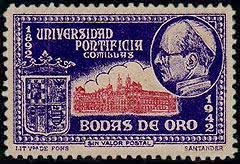
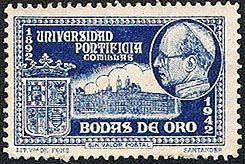

Spanish cinderellas, 1942, the 50th anniversary of the Pontifical
University of Comillas in Madrid
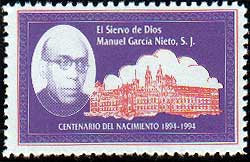
Spanish cinderellas, 1944, the 100th of the birth of Fr. Manuel Garcia Nieto,
SJ, showing the University
The 1942 cinderella was used on a card, but is by its
own admission sin valor postal. This Jesuit university was originally
set up for the training of future priests in 1892 in the town of Comillas
in the province of Santander in the north of Spain. Pius X in 1904 elevated
it to Pontifical stature. In the 1950s the university moved to Madrid
and in 1978 merged with another well-known Jesuit institution, ICAI-ICADE.
Fr. Manuel Garcia Nieto (1894-1969) was spiritual father and professor
of Pastoral and Spiritual Theology at the University of Comillas (1929-1969).
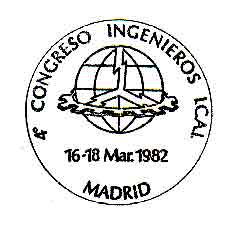
1982, the ICAI (Instituto Católico de Ingenieros) is part of the Jesuit
Pontifical University of Comillas in Madrid


1992-1998, meter stamps for the ICAI (Instituto Católico de Ingenieros)-ICADE
(Instituto Católico de Dirección de Empresas)
components of the Pontifical University
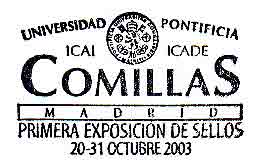
2003, show cancel for the first Stamp Exposition at Comillas
Rafael Matteos, SJ, who has shared much of his collection with us
presented an exhibit entitled
A Mayor Gloria de Dios: San Ignacio
de Loyola y los jesuitas
Cova
de Sant Ignasi, Manresa, Spain
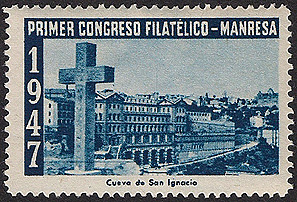
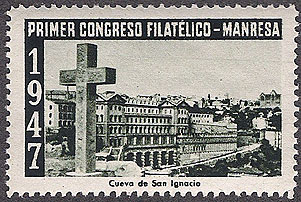
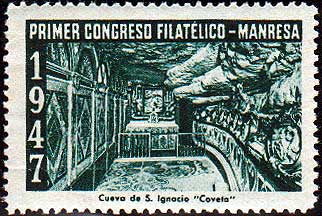
Spanish cinderellas, 1947, the First Philatelic Congress at Manresa, the retreat
house and the interior of the cave
Spanish cinderella issued by the Charity Secretariat of the Railway Brotherhood
of St. Ignatius Loyola


Ignatius Writing the Spiritual Exercises at Manresa, by Fr. Francisco de Paula
Morell, SJ
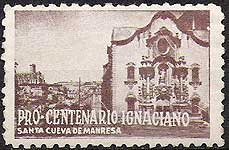

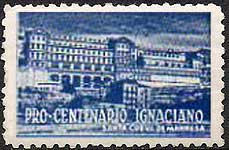
Spanish cinderellas, 1956, the Ignatian Centenary, showing four scenes of the
Holy Cave at Manresa
Fr. Morell's painting, the church, the cave, the sanctuary facing the river.
The set of four vignettes exists in each of the four colors shown above.
The Cova
de Sant Ignasi, Manresa, Spain, is a sanctuary built around the cave
in which St. Ignatius spent much time in 1522 and 1523, praying, doing penance,
and making notes that would become the book of the Spiritual Exercises.
Two of the above cinderellas are based on a painting by Fr. Francisco
de Paula Morell, SJ, Ignatius Writing the Spiritual Exercises at Manresa.
Two show the cave as it is today. It is also a retreat house and spirituality center. One stamp shows the extension
of the retreat house along the river, while another shows the entrance
to the center's church of St. Ignatius on the right side of the building.
Colegio
de Nuestra Señora de la Antigua, Monforte de Lemos

SPAIN, 2001, 4th centenary of the death
of Cardinal Rodrigo, Scott 3102
Behind Cardinal
Rodrigo de Castro (1523 -1600) is the Jesuit College of Nuestra Señora
de la Antigua, located in Monforte de Lemos where the Cardinal has passed
his childhood until 1541. After he was ordained a priest in 1559, he worked
as a judge of the Inquisition, became a counselor of the high court, Bishop
of Cuenca and later of Seville. After making a pilgrimage to Santiago
de Compostela in July 1594, he visited Monforte de Lemos where decided
to found the Jesuit college seen behind him on the stamp. To it he donated
his estate including his art and library, and he also ordered his tomb
to be located there. The building was erected under the direction of the
Jesuit architects Juan de Tolosa and Juan Bustamante.
The
Monastery of San Salvador of Oña, Burgos


SPAIN, 2010, the millennium of the Monastery, and its FDI cancel, Scott
3759
The Monastery of San Salvador, in the Village of Oña, a town of
the Community of Castile and Leon in the Province of Burgos, was founded
in 1011 by the count of Castile Sancho García as a double monastery
for nuns of San Juan of Cillaperlata, and monks of San Salvador of Loberuela.
In 1033 by order of the King of Spain it was given to the Cluniac monks,
and grew until more than seventy monasteries and churches came under its
jurisdiction. In 1506 it was integrated into the Benedictine Congregation
of Valladolid. The Benedictines abandoned the site because of the French
invasion and the later government-forced sale of church property, the
"desamortización de Mandizábal." In 1835 the church
became a parish church, and in 1880 the Jesuits acquired the monastery
and remained there until 1967. The Jesuits made this their Major College
of Philosophy and Theology for the Jesuit Province of Castile. Next to
the college, the Jesuits ran the Secondary School of St. Francis Xavier.
In 1968 the monastic complex passed to the Diputación Provincial
de Burgos as a psychiatric hospital.
Colegio
San Ignacio, Oviedo

1992, meter stamp from the College of
St. Ignatius, a coed Jesuit school in Oviedo, Asturias.
Colegio
SAFA-San Luis, El Puerto de Santa María (Cádiz)
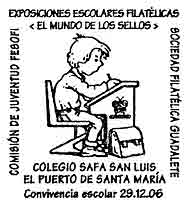
2006, special cancel for a stamp show at SAFA_San Luis
The Jesuit college at El Puerto de Santa María (Cádiz)
was founded in 1864. It closed in 1868 with the expulsion of the Jesuits
and the seizure of the building by the revolutionary junta. The Jesuits
returned in 1875 and reopened the school. In 1925 it became the Jesuit
novitiate and center for humanistic studies, except from 1936-39 when
the government again expelled the Jesuits and seized the building. When
the Jesuit novitiate and center were moved to Cordova in 1961, the school
reopened as the Colegio de San Luis Gonzaga. In 1974 it joined the Professional
Schools of Sagrada Familia (SAFA) and in 1982 was integrated into the
Institution SAFA.
Ebro
Observatory, Roquetes
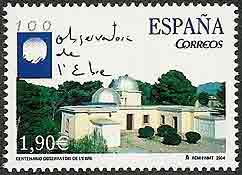
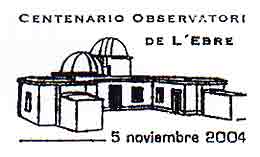
SPAIN, 2004, honoring the centenary of the
observatory, Scott 3327, and its FDI cancel
Ebro Observatory, the Jesuit-run seismological station in Roquetes
(Tarragona), Spain, has functioned continuously from 1904 to the present.
Fr. Richard Cirera, SJ (1864-1932) was it first director. Fr.
Antonio Romañá Pujó, SJ was director from 1939
to 1971. This observatory has astronomical, meteorological, magnetic,
and seismological departments, and publishes the results of its observations
on a monthly basis.
La
Clerecía, Salamanca

SPAIN, 1953, the 7th
centenary of the University of Salamanca, Scott 797

SPAIN, 2001, issued for Salamanca's being named European Cultural City
2002, Scott 3114
at the left: the dome and two towers of the church and the building that was
the Jesuit college

SPAIN, 2016 a souvenir sheet honoring Salamanca as a cultural city shows the towers and dome of the Clerecía to the left, Scott 4124
Opposite the famous Casa de las Conchas in Salamanca
is the Jesuit church of the Holy Spirit, better known as the
Clerecía. It can be seen more clearly on the 2 peseta value
to the right of the Salamanca Cathedral, and on the .45 euro value to
its left. The Clerecía was designed by Juan Gómez de Mora
and was begun in 1617. Beside the Clerecía today is the Universidad
Pontificia, a building with a Baroque cloister built on the site which
formerly housed the Jesuit Royal College. The church and the college were
the initiative of Margaret of Austria, wife of Philip III, in an attempt
to make reparations to the Jesuits for the wrong done to St. Ignatius
when he was imprisoned in Salamanca by the Dominicans.
Colegio
Portaceli, Seville
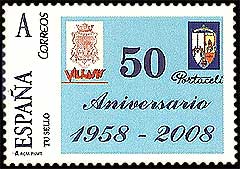
SPAIN, 2008, a personalized stamp for the 50th anniversary of the Colegio
Portaceli in Seville, Spain
The Jesuits have been educators in Seville since 1554, when the College
of San Hermenegildo began. For two centuries, more than a thousand students
a year attended class there. In 1767 Charles
III closed Jesuit schools throughout his domain. Pius VII reestablished
the Society in 1814, but the Jesuits in Spain faced successive expulsions
in 1820, 1835 and 1868. In 1871 a Jesuit school was founded on Argote
de Molina street. But only eleven years later it moved to Malaga.
The real history of the present school begins October 4, 1905, when Cardinal
Spínola presided over the opening of the College of the Immaculate
Heart of Mary [Inmaculado Corazón de María] in the palace
of the Marquis of Villasís. Father Francisco
Tarín, who was renown for his holiness, and Fr. Sánchez
Prieto, who had been prefect of the school in Argote of Molina street
were in charge. In January of 1932 republican authorities ordered the
closing of Villasís, but the school continued. For the first two
months classes were given in secret in the Academia Politécnica
Sevillana and liturgies were celebrated in the Church of St. Martín.
From April onward, lay teachers continued with the task in a house in
Pajaritos Street, with a slight change of the name of the school to the
Sacred Heart of Mary [Sagrado Corazón de María]. Local Jesuits
went to live in the homes of friends close by the school to help the lay
teachers. Only at the end of the Civil War could the school return to
Villasís, and a Mass was offered in its central patio to celebrate
the reopening. In 1950 the school moved to the Huerta del Rey, an enclave
of the old Dominican convent of Portaceli, which the Jesuits had acquired
in 1919 and which had been used for student sporting activities. Cardinal
Segura blessed the foundation stone of the quadrangle that forms the school
of today. In 1972 girls were admitted. In 1998, the Jesuits transferred
ownership of the school to the Loyola Foundation. The personalized stamp
above was commissioned by the class of 1958 to celebrate its 50th anniversary.
It displays the coat of arms of Villasís to the left and that of
Portaceli on the right.
Mission
Office, Seville

SPAIN, 1995, meter stamp for the Japanese Mission, from a mission office
in Seville
The Church of San Ildefonso, Toledo

SPAIN, 2014 a souvenir sheet honoring Toledo as a cultural city, Scott 3983
The towers and dome of the Jesuit Church are on the skyline to the left under the royal post horn.
The Jesuit Church of San Ildefonso (Los Jesuitas) on the Plaza Padre Juan de Mariana (who is buried there) used to be called the Church of John the Baptist. The church has a dome and two towers that rise higher than the cathedral steeple, the view from which is one of the best in Toledo. Construction began in 1628, and the church was consecrated 90 years later in 1718, before its main chapel, sacristy and the "ochavo" holding relics were finished. These were completed almost forty years later. One of the master cathedral architects who worked on it, Bartolomé Zumbigo y Salcedo, designed the exterior featuring the towers and the facade. In 1767, King Charles III expelled the Jesuits from Spain and they lost the church although it was returned to them in 1937.
Centro
Educativo Cristo Rey, Valladolid

SPAIN, 2015, a personalized stamp for the school's 75th anniversary.
At the end of the Spanish Civil War many children were neglected,
abandoned or orphaned, so Father Cid SJ, in 1939 founded the Christo Rey
School arise to help, guide and assist the most disadvantaged and needy
in Valladolid and its surroundings. Its goals were: to meet the most basic
needs of the pupils (housing, food, clothing, education and elementary
education) and teaching practical skills (mechanical manufacturing, carpentry,
shoemaking, graphic arts and printing, and later electricity and electronics,
especially radio). In 1942 the school moved to a farm on the Avenida de
Gijon, where there is the boarding school, chapel, classes and workshops.
The high school kept expanding, adding courses and students until it
came to house 2200 students, 1000 of whom were in boarding school, and
it performs all the pre-university educational levels: childhood education,
primary and secondary school, and baccalaureate.
The
Monastery of Nuestra Señora de Veruela



SPAIN, 1967, Scott 1504-06
The Monastery
of Veruela was founded by the Cistercians in 1146, but the Jesuits
restored it and used it as a novitiate from 1877 until 1973, except when
they were expelled during the Republican Government and the Civil War
(1932-1939). In 1976 the State gave the Provincial Delegation of
Saragossa some control and in 1998 ownership of the property. Here
are three views of Veruela.
NEXT


































